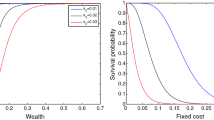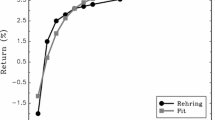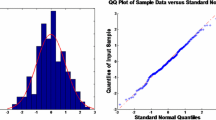Abstract
An important problem in finance is how to invest a portfolio of bonds in order to fund an exogenous stream of multiple liabilities. We prove that minimizing a risk measure, which generalizes Fong and Vasicek’s M-squared, subject to a cash flow dispersion condition, ensures that an asset portfolio dedicated to an exogenous stream of multiple liabilities is fully protected against a parallel shift and has the best worst-case sensitivity to a nonparallel interest rate shift. Further, we show how the new risk measure can be used as part of a risk minimizing strategy for multiple-liability cash flows. The resulting portfolio is fully protected against a parallel interest rate shock of any magnitude and has minimum sensitivity to the worst-case interest rate shock.

Similar content being viewed by others
Notes
Redington’s [11] result can easily be generalized to parallel shifts in a non-flat yield curve.
The money duration gap equals the duration of the assets times the initial asset value minus the duration of the liabilities times the initial liability. In the United States, it is referred to as the dollar duration gap.
Intuitively, this means that assets are more spread out, in some sense, then the liabilities.
If \(V=G=0\), then by Eq. (9)
$$\begin{aligned} \int _{0}^{T}tdF^{+}(t)=\int _{0}^{T}tdF^{-}(t) \end{aligned}$$Let \(F^{+}(t)=\frac{\beta ^{+}(t)}{A}\) and \(F^{-}(t)=\frac{\beta ^{-}(t)}{A}\). \(F^{+}(t)\) and \(F^{-}(t)\) have the properties of distribution function. For a single liability \(F^{-}(s)=U(t-q),\) where U is a unit step function. Let E be the expectation with respect to \(F^{+}\) over the payment dates. For an immunized portfolio \(q=E[t]\). Equation (15) can be written: \( M^{2}= \int _{0}^{T}(t-q)^{2}dF^{+}(t)=E[t-q]^{2}=E[t^{2}]-2qE[t]+q^{2}=E[t^{2}]-q^{2} \). For a single liability, the multiple-liability M-squared Eq. (17) is the same as the \(M^{2}\): \(M_{L}^{2}= \int _{0}^{T}t^{2}dF^{+}(t)-q^{2}=E[t^{2}]-q^{2}\).
A liability stream with constant \(2\%\) growth rate over 30 years is an example of a liability that cannot be immunized with the given set of bonds C. In this case, it is impossible for the duration gap to equal zero, as the duration of the liability stream is 16.9749, but the maximum possible asset duration, equal to the duration of the 30 years bond, is 16.1411.
References
Barber JR, Copper ML (1996) Immunization using principal component analysis. J Portf Manag 23:99–105
Bierwag GO (1977) Immunization, duration, and the term structure of interest rates. J Financ Quant Anal 12:725–742
Bierwag GO (1987) Duration analysis: managing interest rate risk. Ballinger Publishing Company, Cambridge
Bierwag GO, Kaufman GG, Toevs A (1983) Bond portfolio immunization and stochastic process risk. J Bank Res 13:282–291
Cesari R, Mosco V (2018) Optimal management of immunized portfolios. Eur Actuar J 8(2):461–485
Cooper IA (1977) Asset values, interest-rate changes, and duration. J Financ Quant Anal 12:701–724
Fisher L, Weil RL (1971) Coping with the risk of interest-rate fluctuations: returns to bondholders from naive and optimal strategies. J Bus 44:408–431
Fong HG, Vasicek OA (1984) A risk minimizing strategy for portfolio immunization. J Finance 39:1541–1546
Khang C (1979) Bond immunization when short-rates fluctuate more than long-term rates. J Financ Quant Anal 14:1085–1090
Prisman EZ, Shores MR (1988) Duration measures for specific term structures estimations and applications to bond portfolio immunization. J Bank Financ 12:493–504
Redington FM (1952) Review of the principle of life-office valuations. J Inst Actuar 78:286–340
Reitano RR (1991) Multivariate duration analysis. Trans Soc Actuar 43:335–376
Reitano RR (1992) Non-parallel yield curve shifts and immunization. J Portf Anal 18:36–43
Russell WR, Seo TK (1989) Representative sets for stochastic dominance rules. Studies in the economics of uncertainty: in Honor of Josef Hadar. Springer Verlag, New York, pp 59–76
Zheng H (2007) Macaulay durations for nonparallel shifts. Ann Oper Res 151:179–191
Author information
Authors and Affiliations
Corresponding author
Additional information
Publisher's Note
Springer Nature remains neutral with regard to jurisdictional claims in published maps and institutional affiliations.
Appendices
Appendix A: Proof of Lemma 1
Assume \(V=0\) and \(G=0\). Integrating by parts the left-hand side of Eq. (13) and making use of \(\beta \left( 0\right) =0\) and \(\beta (T)=V=0\), we obtain:
A second integration by parts yields:
Integrating by parts the first integral on the right-hand side of Eq. (18) and making use of the condition that \(V=\beta (T)=0\), we obtain:
Since G equals zero, the first term in Eq. (18) is zero:
Appendix B: DDC and immunization for a single-liability portfolio
Assume a single liability is due at date q. We want to show the the DDC is satisfied Eq. (12) when \(A=L\) and \(G=0\):
Note that by the properties of a distribution function \(F^{+}(T)=F^{-}(T)=1\) and \(F^{+}(s),F^{-}(s)\le 1\). By the assumption that \(G=0\), a single liability is due at date \(q=\int _{0}^{T}sdF^{+}\). Then \(F^{-}(s)=U(t-q),\) where U is a unit step function. Clearly, for \(0<t<q\), \( \int _{0}^{t}F^{+}(s)ds>\int _{0}^{t}F^{-}(s)=0\). So examine the case where \( q\le t\le T\):
The inequality holds because \(F^{+}(s)\le 1\).
Appendix C: Proof of Theorem 2
Assume \(V=0\), \(G=0\), \(DDC \), and forward rate restriction Eq. (14) all hold. Let \(u(t)=H(t)\). Then by Lemma 1 with \( u^{\prime }(t)=h(t)\) and \(u^{\prime \prime }(t)=h^{\prime }(t)\), the interest rate sensitivity \(D(h)=-\int _{0}^{T}H(t)d\beta (t)\) from Eq. (5) can be expressed as
If both the DDC and forward rate restriction Eq. (14) hold, the worst-case value of Eq. (20) occurs when \(h^{\prime }(t)=K\):
Integrating by parts, results in:
Again, integrating parts and given that \(V=\beta \left( T\right) =0\), results in:
Setting the money duration gap G from Eq. (9) to zero, results in
Rights and permissions
Springer Nature or its licensor holds exclusive rights to this article under a publishing agreement with the author(s) or other rightsholder(s); author self-archiving of the accepted manuscript version of this article is solely governed by the terms of such publishing agreement and applicable law.
About this article
Cite this article
Barber, J.R. Duration gap with multiple liabilities for nonparallel shifts. Eur. Actuar. J. 13, 637–651 (2023). https://doi.org/10.1007/s13385-022-00329-x
Received:
Revised:
Accepted:
Published:
Issue Date:
DOI: https://doi.org/10.1007/s13385-022-00329-x




